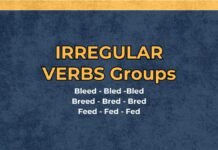Learning irregular verbs is one of the most important steps in mastering English grammar. Unlike regular verbs that simply add “-ed” for past forms, irregular verbs have unique past and past participle forms that must be memorized. Using an irregular verbs list can make this process much easier.
You may want to have a look at our genious irregular verbs groups—verbs grouped by similar patterns, or even start some practice of irregular verbs here.

Understanding Irregular Verbs
Learning irregular verbs is essential for anyone striving to master English grammar. Unlike regular verbs, which follow a predictable “-ed” pattern for past tense and past participle, irregular verbs change in unique ways that must be memorized. An organized irregular verbs list can make this learning process much easier by providing a reference for study and practice. In this article, we will explore the concept of Common Irregular Verbs, explain their usage, and provide a detailed irregular verbs list with examples and practical tips.
What Are Irregular Verbs?
Irregular verbs are verbs that do not follow the standard rules for forming the past tense or past participle. While regular verbs simply add “-ed,” irregular verbs take many different forms. For example, “go” becomes “went,” “eat” becomes “ate,” and “run” becomes “ran.” Mastering irregular verbs is crucial for speaking, writing, and understanding English at a fluent level.
The Importance of Learning Irregular Verbs
Learning irregular verbs is not just a memorization task; it is essential for effective communication. English speakers use irregular verbs in everyday conversations, formal writing, and literature. Knowing the correct forms of Common Irregular Verbs helps you avoid mistakes such as “I seen” instead of “I saw” or “I gone” instead of “I went.” Using an irregular verbs list organized by patterns and frequency can make learning more systematic.
How to Use an Irregular Verbs List
An irregular verbs list is a valuable resource for students and language learners. It typically contains three forms for each verb: the base form, the past simple, and the past participle. Using such a list allows you to:
- Memorize irregular verb forms efficiently.
- Identify patterns among Common Irregular Verbs.
- Use verbs accurately in sentences.
- Practice writing and speaking with correct grammar.
Here is a small example from a typical irregular verbs list:
- Go – Went – Gone
- Eat – Ate – Eaten
- Take – Took – Taken
- See – Saw – Seen
- Come – Came – Come
Common Irregular Verbs: Grouped Patterns
Grouping Common Irregular Verbs according to patterns helps learners memorize them more easily. Below are the most frequent groups used in English.
Group 1: Verbs with Same Past and Past Participle
Some Common Irregular Verbs do not change in the past and past participle forms. Recognizing this group helps simplify learning.
- Cut – Cut – Cut
- Hit – Hit – Hit
- Put – Put – Put
- Let – Let – Let
- Set – Set – Set
- Shut – Shut – Shut
- Cost – Cost – Cost
- Split – Split – Split
- Spread – Spread – Spread
- Bet – Bet – Bet
Example sentences:
- I hit the ball yesterday.
- She cut the paper into shapes.
- They let the children play outside.
Group 2: Verbs with Vowel Change
Many Common Irregular Verbs change vowels in the past simple and past participle forms. Learning these patterns is essential for fluency.
- Begin – Began – Begun
- Drink – Drank – Drunk
- Ring – Rang – Rung
- Sing – Sang – Sung
- Swim – Swam – Swum
- Run – Ran – Run
- Drive – Drove – Driven
- Write – Wrote – Written
- Rise – Rose – Risen
- Choose – Chose – Chosen
Example sentences:
- She sang beautifully at the concert.
- He ran a marathon last month.
- They chose a new book to read.
Group 3: Verbs Ending in -ought
Some Common Irregular Verbs form their past simple and past participle with “-ought.”
- Bring – Brought – Brought
- Buy – Bought – Bought
- Catch – Caught – Caught
- Think – Thought – Thought
- Fight – Fought – Fought
- Teach – Taught – Taught
- Seek – Sought – Sought
- Draw – Drew – Drawn
- Bring – Brought – Brought
- Buy – Bought – Bought
Example sentences:
- I bought a new jacket yesterday.
- They fought for the championship title.
- She taught her students very well.
Group 4: Verbs Ending in -ew/-own
This Common Irregular Verbs pattern includes verbs where the past simple ends in “-ew” and the past participle ends in “-own.”
- Blow – Blew – Blown
- Grow – Grew – Grown
- Know – Knew – Known
- Throw – Threw – Thrown
- Fly – Flew – Flown
- Draw – Drew – Drawn
- Show – Showed – Shown
- Flow – Flew – Flown
- Overthrow – Overthrew – Overthrown
- Outgrow – Outgrew – Outgrown
Example sentences:
- The wind blew all night.
- He threw the ball far.
- The plant has grown significantly.
Group 5: Miscellaneous Common Irregular Verbs
Some Common Irregular Verbs do not fit into specific patterns but are widely used in English.
- Go – Went – Gone
- Be – Was/Were – Been
- Do – Did – Done
- Have – Had – Had
- Say – Said – Said
- Make – Made – Made
- Take – Took – Taken
- See – Saw – Seen
- Come – Came – Come
- Run – Ran – Run
Practical Tips for Learning Irregular Verbs
- Use your irregular verbs list daily in writing exercises.
- Group verbs into Common Irregular Verbs patterns to make memorization easier.
- Create flashcards for each verb with base, past, and past participle forms.
- Listen to English content and note the irregular verbs used.
- Write mini-stories or sentences using verbs from your irregular verbs list.
- Test yourself regularly to reinforce memory.
Common Mistakes with Irregular Verbs
- Using “-ed” instead of the correct past tense (e.g., “goed” instead of “went”).
- Confusing verbs with similar sounds (e.g., “bring-brought” vs. “buy-bought”).
- Incorrect past participle usage in perfect tenses (e.g., “I have went” instead of “I have gone”).
- Skipping learning Common Irregular Verbs patterns.
Conclusion
Mastering irregular verbs is key to achieving fluency in English. Using an organized irregular verbs list and learning Common Irregular Verbs through patterns allows learners to memorize and apply these verbs more effectively. Practice consistently, use verbs in sentences, and revisit the list frequently. Over time, these irregular verbs will become second nature, improving both your written and spoken English skills.



